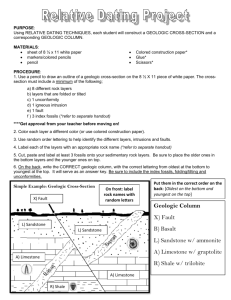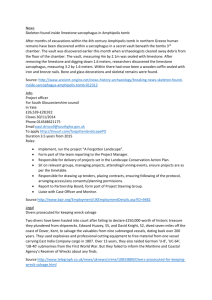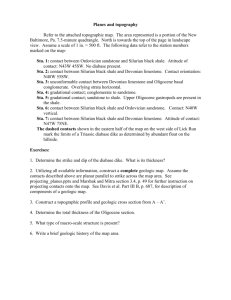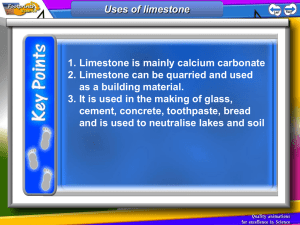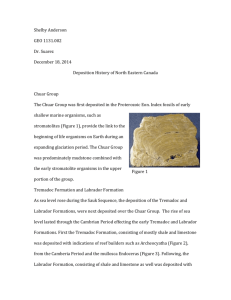Clams - Mr. LaFranca`s Earth Science Class
advertisement
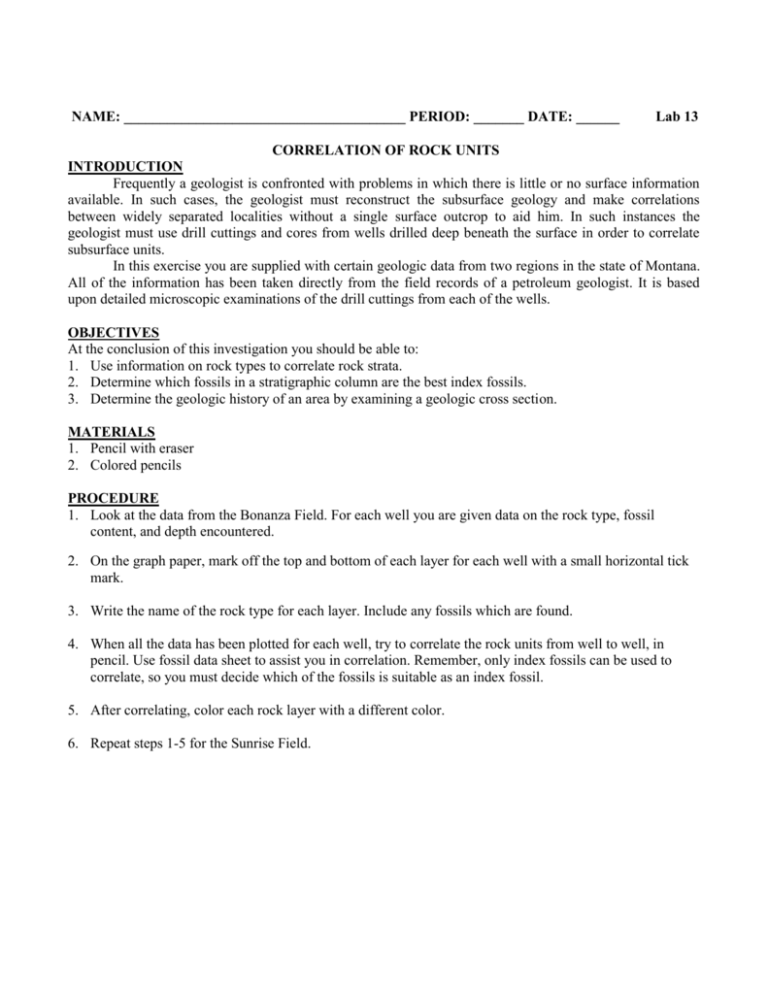
NAME: _______________________________________ PERIOD: _______ DATE: ______ Lab 13 CORRELATION OF ROCK UNITS INTRODUCTION Frequently a geologist is confronted with problems in which there is little or no surface information available. In such cases, the geologist must reconstruct the subsurface geology and make correlations between widely separated localities without a single surface outcrop to aid him. In such instances the geologist must use drill cuttings and cores from wells drilled deep beneath the surface in order to correlate subsurface units. In this exercise you are supplied with certain geologic data from two regions in the state of Montana. All of the information has been taken directly from the field records of a petroleum geologist. It is based upon detailed microscopic examinations of the drill cuttings from each of the wells. OBJECTIVES At the conclusion of this investigation you should be able to: 1. Use information on rock types to correlate rock strata. 2. Determine which fossils in a stratigraphic column are the best index fossils. 3. Determine the geologic history of an area by examining a geologic cross section. MATERIALS 1. Pencil with eraser 2. Colored pencils PROCEDURE 1. Look at the data from the Bonanza Field. For each well you are given data on the rock type, fossil content, and depth encountered. 2. On the graph paper, mark off the top and bottom of each layer for each well with a small horizontal tick mark. 3. Write the name of the rock type for each layer. Include any fossils which are found. 4. When all the data has been plotted for each well, try to correlate the rock units from well to well, in pencil. Use fossil data sheet to assist you in correlation. Remember, only index fossils can be used to correlate, so you must decide which of the fossils is suitable as an index fossil. 5. After correlating, color each rock layer with a different color. 6. Repeat steps 1-5 for the Sunrise Field. BONANZA FIELD DATA TOP BOTTOM +500 +450 +125 -200 -550 -850 +450 +125 -200 -550 -850 Not reached WELL #2 Shale (insects) Limestone (fish) Limestone (eurypterid) Shale (fish) Conglomerate TOP +500 +425 +110 -200 -500 BOTTOM +425 +110 -200 -500 Not reached WELL # 3 Limestone Limestone (fish-eurypterid) Shale Conglomerate TOP +500 +250 -90 -450 BOTTOM +250 -90 -450 Not reached WELL # 4 Shale (bird) Limestone (shark tooth) Limestone (eurypterid) Shale (clam) Conglomerate TOP +500 +400 +100 -250 -650 BOTTOM +400 +100 -250 -650 Not reached WELL # 5 Soil Shale (dinosaur bone) Limestone (clam shell) Limestone (eurypterid, clam shell) Shale Conglomerate TOP +500 +350 +50 -250 -600 -1050 BOTTOM +350 +50 -250 -600 -1050 Not reached WELL # 1 Soil Shale (dinosaur teeth) Limestone (clam shell, insects) Limestone (eurypterid) Shale Conglomerate SUNRISE FIELD DATA Well # 1 Soil Shale (dinosaur bone) Shale (fish scale, insect parts) Siltstone (shark teeth) Conglomerate Limestone (horn coral, clams) Limestone (clams) TOP +2000 +1800 +1600 +1325 +950 +675 +340 BOTTOM +1800 +1600 +1325 +950 +675 +340 Not reached WELL # 2 Soil Shale (dinosaur, fish) Siltstone (clams) Conglomerate Limestone (horn coral) Limestone (clam shell) TOP +2000 +1810 +1610 +1350 +1050 +700 BOTTOM +1810 +1610 +1350 +1050 +700 Not reached WELL # 3 Soil Shale (dinosaurs) Siltstone Conglomerate (insect parts) Limestone (horn coral, clams) Limestone TOP +2000 +1800 +1600 +1580 +1290 +925 BOTTOM +1800 +1600 +1580 +1290 +925 Not reached WELL # 4 Soil Shale (dinosaur, fish scales) Conglomerate Limestone (horn coral) Limestone (clams) TOP +2000 +1800 +1600 +1500 +1220 BOTTOM +1800 +1600 +1500 +1220 Not reached WELL # 5 Soil Shale (dinosaurs, shark teeth) Limestone (horn coral) Limestone (clams) TOP +2000 +1800 +1600 +1490 BOTTOM +1800 +1600 +1490 Not reached FOSSIL TIME CHART FOSSIL Birds Dinosaurs Sharks Insects Eurypterids Horn coral Fish Clam TIME RANGE (millions of years) 163 - present 230 – 66 374 – present 410 – present 430 – 415 458 – 450 530 – present 540 – present LABORATORY QUESTIONS 1. List the order of geologic events (from oldest to youngest) in the Bonanza Field cross-section. Oldest_______________, _______________, _______________, _______________, _______________, _______________, _______________, _______________, _______________ 2. Describe the geologic event that changed the original horizontality of the rock layers in the Bonanza Field cross section. ________________________________________________________________ 3. List the order of geologic events (from oldest to youngest) in the Sunrise Field cross-section. Oldest_______________, _______________, _______________, _______________, _______________, _______________, _______________, _______________, _______________, _______________ 4. Describe the geologic event that changed the original horizontality of the rock layers in the Sunrise Field cross section. _________________________________________________________________________ 5. Which of the fossils did you use as an Index Fossil in the Bonanza Field? Explain why. ____________________________________________________________________________________ In the Sunrise Field? 6. Why did you choose these as the index fossils? Explain why. ____________________________________________________________________________________ 7. Using your Earth Science Reference Tables, name the period in which the index fossils in question 5 existed. _______________________________________ Used the information from the data table in this lab to cut, distribute and paste the fossils on the Bonanza Field diagram and the sunrise field diagram. There is an extra picture in each row to be used as a key Dinosaur Teeth Insects Clam Shells Eurypterids Fishes Birds Shark Teeth Clams Dinosaur Bones Fish Scales Insect Parts Horn Corals Dinosaurs



